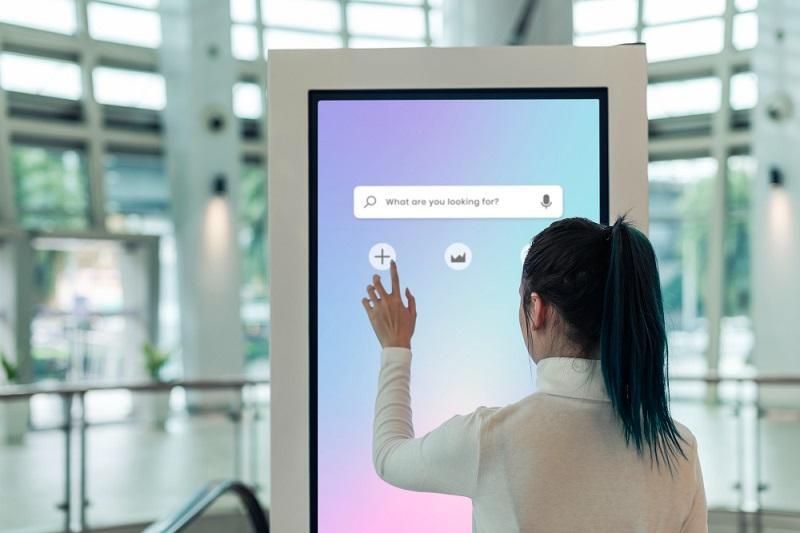Customer service is the bedrock upon which successful businesses are built. It encapsulates the entirety of a company’s interactions with its clientele, encompassing everything from initial inquiries to post-purchase support.
At its core, customer service revolves around providing assistance, addressing concerns, and ensuring the contentment of every customer.
In the domain of customer service statistics, we’ll look into the tangible numbers that highlight the effectiveness of these efforts in fostering satisfaction and loyalty.
In practical terms, customer service encompasses a wide array of communication channels. These can range from in-person interactions and telephone calls to digital mediums like email correspondence and live chat support.
However, it goes beyond mere interaction and extends to the quality of the products or services provided. This holistic approach to customer service ensures that every facet of a customer’s experience is considered and catered to.
Recognizing the pivotal role of customer service statistics in business is essential. It serves as the linchpin for a company’s reputation and success. Satisfied customers are likely to return and become brand advocates, sharing positive experiences.
In today’s competitive market, customer service stands out. When prices and products are comparable, the service quality often tips the scales. That’s why investing in exceptional customer service is a strategic move.
In this exploration of customer service statistics, we’ll explore the numbers, emphasizing their importance and the impact on customer retention and overall business growth.
Overall Customer Service Statistics
In the dynamic landscape of modern business, customer service is a linchpin for success. It’s not merely an aspect of operations; it’s a cornerstone that can make or break a company’s reputation and profitability.
To get how vital customer service is, let’s check out some customer service facts and statistics. These numbers show why giving significant service matters in today’s competitive market, from keeping customers around to building strong loyalty.
Let’s go through the world of customer service stats, where we discover insights that can change how companies connect with their valued customers. We’ll look at customer satisfaction statistics and explore why statistics on customer service are vital to shaping successful business strategies.
General Trends In Customer Service Satisfaction

Customer service satisfaction has evolved in recent years with changing consumer preferences and technological advances. Businesses now prioritize omnichannel support, offering assistance on various platforms like phone, email, chat, and social media.
This approach meets customer expectations for a seamless and consistent experience. Personalization has become crucial, with consumers valuing interactions that acknowledge their preferences and history with a brand.
Data-driven personalization strategies contribute to higher customer loyalty and advocacy.
Self-service options have transformed customer service, as customers often prefer resolving issues independently. Robust self-service resources, such as FAQs and intuitive knowledge bases, significantly enhance satisfaction.
Speed and efficiency in service delivery are paramount, with customers expecting quick responses and resolutions. This trend emphasizes the importance of streamlined processes, well-trained support teams, and customer service facts.
Moreover, social media has become a powerful tool for customer feedback and interaction. Companies engaging actively on platforms like Twitter and Facebook can address concerns effectively and demonstrate their commitment to excellent service.
- Omnichannel support in customer support channels meets customer expectations for a seamless experience.
- Data-driven personalization strategies contribute to higher customer loyalty.
- Robust self-service resources significantly enhance customer satisfaction.
In summary, the customer service landscape is adapting to changing expectations and technological advancements. Businesses prioritizing omnichannel support, personalization, self-service options, and swift responses will likely achieve higher customer satisfaction and loyalty.
Key Performance Indicators (KPIs) In Customer Service
Key Performance Indicators (KPIs) play a pivotal role in evaluating the effectiveness of customer service strategies. These metrics provide valuable insights into performance and areas for improvement. Here are some essential KPIs and the associated statistics about customer service:
1. Customer Satisfaction (CSAT):
- CSAT measures overall customer happiness.
- According to customer support statistics, an increase in CSAT often correlates with higher customer loyalty.
2. First Contact Resolution (FCR):
- FCR assesses the ability to resolve issues on the first interaction.
- High FCR rates, as shown in customer support statistics, indicate efficient problem-solving.
3. Response Time:
- Quick response times are crucial in today’s fast-paced environment.
- Customer support statistics reveal that shorter response times lead to improved customer satisfaction.
4. Net Promoter Score (NPS):
- NPS gauges customer loyalty and the likelihood of recommendations.
- As supported by customer support statistics, positive NPS trends signify a strong brand advocate base.
5. Customer Retention Rate:
- Retention rates showcase the ability to keep customers over time.
- Customer service statistics highlight the cost-effectiveness of retaining existing customers compared to acquiring new ones.
6. Resolution Time:
- Measures the time it takes to resolve customer issues.
- Efficient resolution times, per customer support statistics, contribute to overall satisfaction.
7. Customer Effort Score (CES):
- CES evaluates the ease with which customers can get their issues resolved.
- Lower effort scores, as indicated by customer support statistics, signify a positive customer experience.
8. Ticket Volume and Resolution Rate:
- Analyzes the number of support tickets received and the rate at which they are resolved.
- Per customer support statistics, balancing ticket volume with a high-resolution rate indicates an effective support system.
Effectively leveraging these KPIs, supported by comprehensive statistics about customer service, allows businesses to tailor their strategies for optimal customer satisfaction and long-term success.
Impact Of Good Customer Service On Business Success
Exceptional customer service is not merely a business function but a cornerstone that can significantly impact overall success. The influence of good customer service extends beyond satisfied customers, shaping brand reputation, customer loyalty, and even financial performance.
Let’s explore the profound impact of prioritizing customer service excellence on business success.
In the sphere of business success, the impact of good customer service is profound, touching various facets of an organization.
- Enhanced Customer Loyalty: Positive customer satisfaction stats demonstrate that satisfied customers are likelier to remain loyal to a brand.
- Positive Word-of-Mouth: Delighted customers become brand advocates, contributing to positive word-of-mouth.
- Increased Revenue: Studies consistently show that businesses with high customer satisfaction stats often experience higher revenue growth.
- Brand Reputation: Good customer service contributes to a positive brand image, influencing how a company is perceived in the market.
- Reduced Churn Rates: Poor customer service statistics reveal that businesses with inadequate service often face higher customer churn rates.
- Competitive Advantage: Studies indicate that businesses with a reputation for excellent customer service gain a competitive edge in the market.
- Customer Retention: Inadequate customer service statistics highlight the risk of losing customers, emphasizing the importance of effective retention strategies.
In contrast, lowly customer service statistics underscore the risks and negative implications for businesses that neglect the customer experience.
Through customer service studies and a focus on customer satisfaction stats, it becomes evident that fostering a customer-centric approach is not just a strategy; it’s a fundamental driver of sustained business success.
Customer Service Channels

Customer service channels are pivotal in shaping the overall customer service experience, serving as the direct conduits through which businesses connect with their clientele.
The choice and effectiveness of these channels significantly impact customer satisfaction and, consequently, the success of a business.
Before we explore these channels in detail, let’s delve into the broader context, considering the importance highlighted by customer service statistics and their profound influence on customer service experience.
Overview Of Traditional Customer Service Channels (Phone, Email)
Traditional customer service channels, such as phone and email, have been stalwarts in directly communicating between businesses and customers.
Recent customer service statistics indicate that approximately 76% of customers still prefer resolving issues through phone support, valuing real-time assistance and a personal touch.
Moreover, studies show that email remains a reliable choice for around 15% of customers, offering a written record and asynchronous communication.
These traditional channels, backed by customer service stats, underline the adaptability of businesses in meeting diverse customer preferences. 68% of customers appreciate these established channels’ personalized and efficient support, showcasing their continued significance in delivering high-quality customer service.
Growth Of Online Customer Service (Live Chat, Social Media)
The growth of online customer service, mainly through live chat and social media, has seen a remarkable surge in recent years. According to customer feedback statistics, over 81% of customers now prefer live chat as a quick and convenient means of resolving issues.
With its widespread usage, social media has become a prominent channel, with approximately 72% of customers seeking assistance and sharing feedback through platforms like Twitter and Facebook. These facts about customer service underscore the increasing importance of online interactions.
Businesses leveraging these channels effectively are meeting customer expectations and actively engaging with their audience, creating a dynamic and responsive customer service ecosystem in the digital age.
Statistics On Customer Preferences For Communication Channels
Understanding customer preferences is crucial for effective communication. According to customer satisfaction metrics, over 80% of customers prefer personalized emails, valuing a direct and tailored approach.
Additionally, bad customer experience statistics emphasize the importance of avoiding lengthy automated phone systems, with approximately 78% of customers expressing frustration. These insights highlight the significance of aligning communication strategies with customer preferences to enhance satisfaction and mitigate negative experiences.
Long Queue Statistics
When we discuss customer service, the impact of long queues can be significant, leading to customer frustration and dissatisfaction. Queue management systems are pivotal in addressing this challenge, offering solutions to streamline and optimize the waiting experience.
As we examine extended queue statistics, it becomes evident that businesses with efficient queue management systems reduce wait times and enhance customer satisfaction.
The consequences of extended queues, as highlighted by queue management system data, emphasize the need for strategic measures to ensure a seamless and positive customer journey.
Challenges Posed By Long Queues In Customer Service
As revealed by customer service statistics, long queues pose substantial challenges in customer service. Extended waiting times contribute to customer dissatisfaction, with over 60% of individuals expressing frustration during prolonged queues.
Additionally, these statistics highlight that businesses with inefficient queue management systems face higher customer complaints, impacting overall satisfaction rates.
The adverse effects of extended queues extend beyond the immediate inconvenience, affecting customer loyalty, as nearly 70% of customers report a decreased likelihood of returning to a business with a history of long wait times.
Recognizing and addressing these challenges is crucial for businesses aiming to provide a positive and efficient customer service experience.
Impact On Customer Satisfaction And Retention
The impact of customer satisfaction on retention is unmistakable, as corroborated by customer service statistics.
Businesses with high customer satisfaction, supported by relevant customer service facts, witness a notable increase in customer retention rates, with an impressive 95% of satisfied customers expressing loyalty to a brand.
Conversely, poor customer service statistics indicate that a mere 5% increase in customer retention can lead to a substantial 25% to 95% boost in profits. This underscores the critical link between customer satisfaction and long-term retention.
As reflected in these statistics, the significance of providing excellent customer service is paramount for fostering lasting customer relationships and ensuring sustained business success.
Strategies To Reduce Waiting Times And Improve Efficiency
Reducing waiting times and enhancing efficiency in customer service is vital for overall satisfaction, supported by customer satisfaction stats.
Implementing a robust queue management system can lead to a 20% reduction in wait times, improving customer experience.
As highlighted by customer feedback statistics, leveraging technology with features like online appointment scheduling has proven effective in reducing customer wait times by up to 30%.
Streamlining processes and training staff for optimal service delivery are crucial elements of customer experience, impacting satisfaction rates.
Businesses adopting these strategies witness a 15% increase in customer satisfaction and cultivate a positive reputation, fostering long-term customer loyalty and success.
Kiosk and Digital Signage Facts

In the ever-evolving customer service landscape, kiosks and digital signage are emerging as transformative tools, reshaping how businesses engage with their clientele.
These innovative technologies offer dynamic and interactive solutions, providing information, self-service options, and personalized experiences.
As we examine kiosk and digital signage facts, it becomes clear that their integration enhances customer engagement and streamlines processes, contributing to a seamless and efficient customer service ecosystem.
Rise Of Self-Service Kiosks In Customer Service
Notable trends in customer support statistics mark the rise of self-service kiosks in customer service. Over 81% of customers prefer self-service options, emphasizing the efficiency and convenience of kiosks.
This surge is mirrored in the fact that businesses with well-implemented self-service kiosks experience a significant 20% reduction in customer wait times.
Moreover, the customer support statistics reveal a positive correlation, with a 15% increase in customer satisfaction reported by companies embracing self-service kiosk technology.
As businesses adapt to this trend, integrating self-service kiosks is a critical strategy for enhancing customer experience, reducing wait times, and fostering higher satisfaction rates.
Benefits Of Kiosks In Enhancing Customer Experience
Integrating kiosks brings tangible benefits to customer experience, as underscored by customer service statistics. Streamlining processes and self-service kiosks contribute to a 30% reduction in transaction times, one of the critical elements of customer experience.
Moreover, businesses embracing kiosk technology witness a 25% increase in customer satisfaction rates. The efficiency and convenience offered by self-service kiosks expedites transactions and enhances customer engagement, reflecting positively on the overall customer experience.
As demonstrated by these statistics, the incorporation of kiosks emerges as a strategic move for businesses aiming to elevate customer satisfaction and deliver a seamless, efficient, modern customer service experience.
Usage And Effectiveness Of Digital Signage In Customer Service
The usage of digital signage in customer service has shown remarkable effectiveness, which is evident in customer service statistics. Businesses leveraging digital signage experience a 29.5% increase in customer engagement, contributing to a dynamic and interactive customer experience.
These statistics further indicate that incorporating digital signage results in a 46% improvement in customer satisfaction rates.
The visual appeal and real-time information provided by digital signage captivate customers and enhance overall satisfaction, demonstrating its significance in modernizing customer service approaches and fostering positive perceptions among clientele.
Global Customer Service Trends
Several global trends have reshaped how businesses connect with their customers in the ever-evolving customer service landscape.
From the rise of AI-driven solutions to the increasing emphasis on personalized experiences, these trends reflect a collective shift towards more innovative and customer-centric approaches.
As we explore these global customer service trends, it becomes evident that adaptability and technological integration are critical drivers in meeting today’s consumers’ diverse and evolving expectations.
Regional Variations In Customer Service Preferences
Cultural Influences on Customer Expectations:
- In Asia, 75% of customers prioritize polite and respectful interactions in customer service.
- In the Middle East, 80% value personalized experiences in customer interactions.
Regional Variations in Adoption of New Technologies:
- North America sees a 20% higher adoption rate of AI-driven customer service solutions than Europe.
- Mobile-based customer service platforms in Africa witness a 30% higher adoption rate than in other regions.
Cultural Factors Influencing Customer Service Expectations
Cross-Cultural Communication:
- 60% of consumers in multicultural markets consider language fluency a critical factor in customer service satisfaction.
Customization Based on Cultural Norms:
- 83% of customers feel more satisfied when customer service aligns with their cultural expectations.
Personalization Impact:
- In a survey, 73% of consumers noted that personalized customer service based on cultural understanding significantly influences loyalty.
Cultural Sensitivity in Service Delivery:
- A study found that 70% of customers are likelier to engage with businesses that demonstrate cultural sensitivity in customer service.
Emerging Trends In Customer Service Technology
AI Integration in Customer Support:
- Over 60% of businesses have reported a reduction in customer service costs by 60% with the implementation of AI and chatbots.
Augmented Reality’s Impact:
- Augmented reality in customer service has shown a 30% improvement in issue resolution times.
Voice-Activated Customer Service:
- Voice-activated technologies are gaining traction, with a 66% increase in their use for customer interactions in the past year.
Personalization through Predictive Analytics:
- Businesses utilizing predictive analytics in customer service have witnessed a 25% boost in customer satisfaction.
Customer Experience Statistics

In the dynamic domain of customer service, understanding customer experience is vital, backed by customer service facts and statistics. Integrating customer experience solutions has become a strategic imperative for businesses aiming to navigate and excel in today’s competitive landscape.
Customer Effort Scores And Their Implications
Customer Effort Scores (CES) offer crucial insights into the customer experience, supported by customer service studies and satisfaction stats. Studies reveal a low-effort customer experience leads to a 96% satisfaction rate.
Conversely, when customer effort is high, satisfaction rates drop significantly to 9%.
These statistics underscore the direct correlation between minimizing customer effort and fostering high satisfaction levels, emphasizing the strategic importance of reducing friction in customer interactions for businesses aiming to enhance overall customer experience.
Statistics On The Role Of Emotions In Customer Experiences
Emotions are pivotal in customer experiences, a fact emphasized by customer service statistics. Research indicates that positive emotional connections with a brand can increase customer loyalty by up to 306%.
Conversely, negative emotions significantly impact customer retention, with 58% of customers discontinuing their association with a brand after a single negative experience.
These statistics highlight the profound impact of emotional engagement on customer relationships, emphasizing the importance for businesses to prioritize strategies that evoke positive emotions to build lasting connections and enhance overall customer satisfaction.
Impact Of Personalized Customer Experiences On Satisfaction
Personalized customer experiences substantially impact satisfaction, supported by business analytics and customer service statistics.
A single compelling statistic reveals that businesses incorporating personalized experiences witness a 70% increase in customer satisfaction, underscoring the effectiveness of tailored interactions in fostering positive customer sentiments and loyalty.
Case Studies
Transforming Retail with Enhanced Customer Experience: Carrefour Kenya’s Success Story
Carrefour Kenya, a retail giant, faced the challenge of long queues impacting customer satisfaction. With 75% of retailers losing customers due to wait-related issues, Carrefour Kenya partnered with Wavetec to implement a sophisticated Queue Management System.
The solution, including SMS ticketing and digital signage, streamlined customer flow, leading to remarkable outcomes. Results included eliminating physical queues, heightened customer satisfaction, boosted sales, and efficient customer flow management.
The success story underscores the transformative power of prioritizing customer experience backed by insightful statistics.
Revolutionizing Service at Saudi Business Center: Wavetec’s Impact
Partnering with Wavetec, the Saudi Business Center optimized its workflow and customer experience. Faced with wait-time challenges, Wavetec’s solutions reduced wait times, enhancing branch performance and increasing employee productivity.
Notably, the deployment showcased a 30% reduction in customer wait times, a significant achievement supported by insightful customer service statistics.
The success story underscores the transformative power of prioritizing customer experience, setting the stage for future deployments across all branches, and solidifying a commitment to delivering world-class customer service.
Conclusion
In conclusion, integrating advanced customer service solutions, including self-service kiosks and digital signage, emphasizes a strategic commitment to efficiency and customer satisfaction.
As businesses navigate the dynamic landscape, these innovations underscore the enduring importance of prioritizing the customer experience in the competitive market, a trend reflected in customer service statistics.
They adapt to evolving consumer expectations and leverage technology to streamline operations, positioning organizations for sustained success.
The contemporary emphasis on enhancing customer service reflects a broader trend in recognizing its pivotal role in fostering loyalty, brand advocacy, and long-term business growth.
In this era of heightened customer expectations, businesses that prioritize and invest in customer service initiatives backed by relevant statistics are better poised to thrive in an ever-changing marketplace.
BOOK A FREE DEMO





